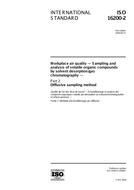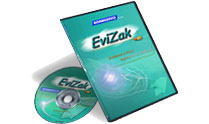Wir benötigen Ihre Einwilligung zur Verwendung der einzelnen Daten, damit Sie unter anderem Informationen zu Ihren Interessen einsehen können. Klicken Sie auf "OK", um Ihre Zustimmung zu erteilen.

ISO 16200-2:2000
Workplace air quality — Sampling and analysis of volatile organic compounds by solvent desorption/gas chromatography — Part 2: Diffusive sampling method
Automatische name übersetzung:
Workplace Luftqualität - Probenahme und Analyse flüchtiger organischer Verbindungen Lösemitteldesorption / Gaschromatographie - Teil 2: Probenahme mit Passivsammlern Verfahren
NORM herausgegeben am 8.6.2000
Informationen über die Norm:
Bezeichnung normen: ISO 16200-2:2000
Ausgabedatum normen: 8.6.2000
SKU: NS-426946
Zahl der Seiten: 32
Gewicht ca.: 96 g (0.21 Pfund)
Land: Internationale technische Norm
Kategorie: Technische Normen ISO
Kategorie - ähnliche Normen:
Die Annotation des Normtextes ISO 16200-2:2000 :
Description / Abstract: This part of ISO 16200 gives general guidance for the sampling and analysis of volatile organic compounds (VOCs) in air. This part of ISO 16200 is applicable to a wide range of VOCs, including hydrocarbons, halogenated hydrocarbons, esters, glycol ethers, ketones and alcohols. A number of devices and sorbents are recommended for the sampling of these VOCs, each sorbent having a different range of applicability. NOTE Activated coconut shell charcoal is frequently used. Very polar compounds may require derivatization; very low boiling compounds will only be partially retained by the sorbents and can only be estimated qualitatively. Semi-volatile compounds will be fully retained by the sorbents, but may only be partially recovered. This part of ISO 16200 is valid for the measurement of airborne vapours of VOCs in a concentration range of approximately 1 mg/m3 to 1000 mg/m3 individual organic for an exposure time of 8 h. The upper limit of the useful range is set by the sorptive capacity of the sorbent used and, subject to dilution of the analysed solution, by the linear dynamic range of the gas chromatograph column and detector or by the sample splitting capability of the analytical instrumentation used. The lower limit of the useful range depends on the noise level of the detector and on blank levels of analyte and/or interfering artefacts on the sampling devices or in the desorption solvent. Artefacts are typically sub-nanogram for activated charcoal, but higher levels of aromatic hydrocarbons have been noted in some batches.
Empfehlungen:
EEviZak – alle Gesetze einschließlich ihrer Evidenz in einer Stelle
Bereitstellung von aktuellen Informationen über legislative Vorschriften in der Sammlung der Gesetze bis zum Jahr 1945.
Aktualisierung 2x pro Monat!
Brauchen Sie mehr Informationen? Sehen Sie sich diese Seite an.



 Cookies
Cookies
